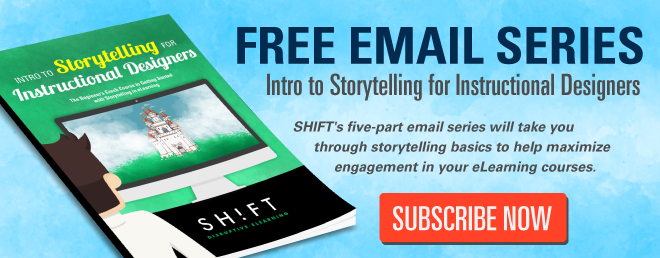If you scour Craigslist and LinkedIn regularly, you will often come across this ad:
Creative instructional designers wanted.
Requirements:
- Strong writing and storyboarding skills
- Ability to write engagingly for many different audiences
- Ability to convert "raw content" into crisp eLearning scripts
- Ability to explain complex concepts lucidly
- Ability to bring alive dull technical topics
- Excellent grammar, spelling and formatting
- Desire to improve skills by attending eLearning Webinars and joining Instructional Design groups
Phew!
It is evident that companies are on the lookout for instructional designers who can do more than just put together a bullet list of tips. They want people who can create evocative prose that touches the audience's hearts, appeals to their logic, and rouses them to action. They want creative writers and out-of-the-box thinkers.
Especially, companies are looking for good writing skills. The ability to write well, they say, reflects the ability to think well.
Your learners are crunched for time and have short attention spans. You have to create scenarios that are as riveting as a whodunit, dialogs that sound natural, and characters that seem as real as the average man on the street. However, you have to also ensure your script delivers the learning lucidly.

In short, to get the nod from a prospective employer, you have to excel at both fiction- and non-fiction writing. There are a variety of activities that can help you improve your creative writing ability for eLearning:
1. Write every day
Practice indeed makes a man perfect. The more you write, the better you become at communicating your thoughts and ideas. Here's how to go about it:
- Create a daily schedule, so you have a fixed hour of the day when you can write without distractions.
- Write for a variety of genres—newsletters, articles, advertisement copies, blogs, grants, news pieces, stories, and white papers. If need be, create your own projects.
Keep a journal. Journaling makes you adept at expressing your thoughts lucidly.
2. Read
The more you read, the more you are exposed to novel ideas, new writing styles, and interesting characters. Reading expands your knowledge and familiarizes you with experiences that you may not encounter in your daily life. Reading is the best way to learn the nuances of a language—how words come together to create moods and how staid definitions can be spiced up with analogies.
Don't be picky; read everything from blogs to newspapers and from poetry and classic romance novels to whodunits and advertisements.
3. Study great writers and get inspired
As you read, make it a habit of taking notes. You can copy your favorite passages from books, bookmark blog posts, or save texts or web pages on Evernote. Try to spot the patterns that make these writings stick—the use of words in an advertisement, the catchy headlines that make you click on emails, analogies you can relate to, the easy flow and the natural dialogs in fictional stories, or the matter-of-fact tone of newspaper stories.
4. Build your vocabulary
Don’t get stuck using the same worn terms over and over again. Build your vocabulary, so you are never at a loss hunting for the right word to express an idea. Reading definitely expands your stock of words. Keep a diary handy when you read. When you stumble on an unfamiliar word, look it up in the dictionary and jot down the meaning.
A simple thing you can do: Check out Word of the Day every day.
5. Banish the curse of knowledge
You have sifted through reams of paper, read loads of PDFs, and browsed countless websites to learn and understand what you have to teach. You now know more on the subject than the average man on the street, but your audience doesn't.
Do not succumb to the curse of knowledge; explain concepts, simplify jargons, spell out acronyms, get rid of funnecessary adjectives and adverbs and write lucidly.
The only way to defeat the curse of knowledge, is by stepping into the shoes of your target audience, understanding their needs, and delivering accordingly. In other words, showing empathy! Your writing is effective only if you can communicate your ideas lucidly, facilitate a seamless transfer of learning from the course to the desk, and successfully bring about a change in your audience's behavior or thought patterns or elicit a positive action from them.
6. Tweet regularly
Yes, you read right. Twitter makes you a better writer.
Tweeting to express your thoughts within 140 characters helps you write crisply, avoid verbosity, and nail down your emotions using just the right words (which are not adjectives, adverbs, and unconventional abbreviations). Tweeting regularly also helps you gauge the way your audience consumes and makes sense of information.
According to Erik Deckers, to learn how to tweet effectively you must apply these:
- Distill your thoughts into the most expressive nouns and verbs.
- Cut the adverbs.
- Use adjectives sparingly.
7. Be ruthless when editing your work
We all have our favorite passages we have so painstakingly conjured up. We love to use certain words and phrases. But it is not you who you are writing for. So you have to edit your work, ruthlessly, to make it speak the language your audience understands. You have to make your eLearning course a conversation with your learner!
8. Read aloud what you have written
Learners expect their eLearning courses to be flawless; a minor spelling error, typo, or grammar mistake is enough to diminish the credibility of content.
Reading aloud what you have written helps you spot grammatical mistakes, sentence structures that sound odd, and gaps in flow or logic. This practice will help you pick up some mistake or patterns that you hadn't noticed even as you wrote it. Also, is an effective revision strategy that ensures your writing is lucid, concise, coherent, and engaging.
9. Try free writing as a regular exercise
Free writing means writing whatever comes in your head. Even though it sound simple, it’s very effective. It helps you get your creative juices flowing and get your brain in gear. Somehow doing this exercise is liberating; it frees your writer’s voice and synchs you to the inner creativity that lies somewhere deep underground.
Try freewriting as a regular exercise. Here are some guidelines, you might want to check out.
Recommended reads:
- Content Writer's Guide: Simple Tips to Hook, Engage, and Teach
- Designing Words That Work in eLearning
- Tips and Tricks to Improve Your Creative Writing
- 10 Types of Writing for eLearning
- Unconvential Ways to Become a Better Writer
Writing effectively helps you create memorable eLearning courses that can keep your audience hooked and transform their lives for the better. Tell us what you to to improve your creative writing skills in the comments below.



